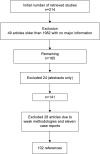Virus-induced secondary bacterial infection: a concise review
- PMID: 26345407
- PMCID: PMC4554399
- DOI: 10.2147/TCRM.S87789
Virus-induced secondary bacterial infection: a concise review
Abstract
Respiratory diseases are a very common source of morbidity and mortality among children. Health care providers often face a dilemma when encountering a febrile infant or child with respiratory tract infection. The reason expressed by many clinicians is the trouble to confirm whether the fever is caused by a virus or a bacterium. The aim of this review is to update the current evidence on the virus-induced bacterial infection. We present several clinical as well in vitro studies that support the correlation between virus and secondary bacterial infections. In addition, we discuss the pathophysiology and prevention modes of the virus-bacterium coexistence. A search of the PubMed and MEDLINE databases was carried out for published articles covering bacterial infections associated with respiratory viruses. This review should provide clinicians with a comprehensive idea of the range of bacterial and viral coinfections or secondary infections that could present with viral respiratory illness.
Keywords: bacteria; infection; risk; virus.
Figures
References
-
- Regamey N, Kaiser L, Roiha HL, et al. Paediatric Respiratory Research Group Viral etiology of acute respiratory infections with cough in infancy: a community-based birth cohort study. Pediatr Infect Dis J. 2008;27(2):100–105. - PubMed
-
- Greenberg SB. Respiratory viral infections in adults. Curr Opin Pulm Med. 2002;8(3):201–208. - PubMed
Publication types
LinkOut - more resources
Full Text Sources
Other Literature Sources



